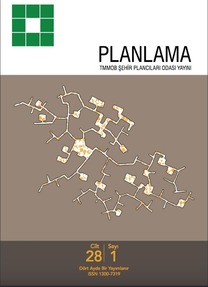İklim Duyarlı Kentsel Tasarım İlkeleri: Erzurum Kenti Örneği
Climate Sensitive Urban Design Principles: The Case of Erzurum City
___
- Ali-Toudert, F., & Mayer, H. (2007). Effects of asymmetry, galleries, overhanging façades and vegetation on thermal comfort in urban street canyons. Solar Energy, (81), 742–754. https://doi.org/10.1016/j.solener.2006.10.007
- Bruse, M., & Fleer, H. (1998). Simulating surface-plant-air interactions inside urban environments with a three dimensional numerical model. Environmental Modelling and Software, 13, 373–384. https://doi.org/10.1016/ S1364-8152(98)00042-5
- Chow, W. T. L., Pope, R. L., Martin, C. A., & Brazel, A. J. (2011). Observing and modeling the nocturnal park cool island of an arid city: horizontal and vertical impacts. Theoretical and Applied Climatology, 103(1), 197–211. https://doi.org/10.1007/s00704-010-0293-8
- De, B., & Mukherjee, M. (2016). Impact of Canyon Design on Thermal Comfort in Warm Humid Cities: A Case of Rajarhat- Newtown, Kolkata. Fourth International Conference on Countermeasure to Urban Heat Island, 2016, ( June), 30–31.
- Dursun, D., & Yavas, M. (2016). Urbanization and the Use of Climate Knowledge in Erzurum, Turkey. Procedia Engineering, 169. https://doi. org/10.1016/j.proeng.2016.10.040
- Ebrahimabadi, S. (2012). Improvements in Addressing Cold Climate Factors in Urban Planning and Design. Lulea University of Technology.
- Emmanuel, R. (2005). Thermal comfort implications of urbanization in a warm-humid city: the Colombo Metropolitan Region (CMR), Sri Lanka. Building and Environment, 40(12), 1591–1601. https://doi.org/https:// doi.org/10.1016/j.buildenv.2004.12.004
- Golany, G. S. (1996). Urban design morphology and thermal performance. Atmospheric Environment, 30(3), 455–465. https://doi.org/10.1016/1352- 2310(95)00266-9
- Kleerekoper, L. (2016). Urban climate design: Improving thermal comfort in Dutch neighbourhoods (Delft University of Technology; Vol. 11). https:// doi.org/10.7480/abe.2016.11
- Krüger, E. L., Minella, F. O., & Rasia, F. (2011). Impact of urban geometry on outdoor thermal comfort and air quality from field measurements in Curitiba, Brazil. Building and Environment, 46, 621–634. https://doi. org/10.1016/j.buildenv.2010.09.006
- Maggiotto, G., Buccolieri, R., Santo, M. A., Leo, L. S., & Di Sabatino, S. (2014). Study of the Urban Heat Island in Lecce (Italy) by means of ADMS and ENVI-MET. International Journal of Environment and Pollution.
- Mills, G. (1999). Urban climatology and urban design. ICB-ICUC, 99, 15th.
- Mutlu, E., Yılmaz, S., Yılmaz, H., & Mutlu, B. (2018). Analysis of Urban Settlement Unit By Envi-Met According To Different Aspects In Cold Regions. 6th Annual International Conference on Architecture and Civil Engineering, 519. Singapore.
- Ng, E., Chen, L., Wang, Y., & Yuan, C. (2012). A study on the cooling effects of greening in a high-density city: An experience from Hong Kong. Building and Environment, 47, 256–271. https://doi.org/10.1016/j.buildenv.2011.07.014
- Pressman, N. (1995). Urban design: The northern dimension. In C. Charette (Ed.), Issues in Canadian Urban Design (pp. 221–267). Institute of Urban Studies.
- Pressman, N. (2004). Shaping Cities for Winter. Climatic Comfort and Sustainable Design. Prince George, Winter Cities Associatio (ISBN 0-9698761-1-4). In Cahiers de géographie du Québec (Vol. 48). https:// doi.org/10.7202/011810ar
- Scherer, D., Fehrenbach, U., Beha, H. D., & Parlow, E. (1999). Improved concepts and methods in analysis and evaluation of the urban climate for optimizing urban planning processes. Atmospheric Environment, 33 (24–25), 4185–4193. https://doi.org/10.1016/S1352-2310(99)00161-2.
- Taleghani, M., Kleerekoper, L., Tenpierik, M., & Van Den Dobbelsteen, A. (2015). Outdoor thermal comfort within five different urban forms in the Netherlands. Building and Environment, 83, 65–78.
- Toy S., Yilmaz S. and Yilmaz, H. (2007). Determination of bioclimatic comfort in three different land uses in the city of Erzurum, Turkey, Building and Environment, 42(3),1315-1318.
- Tsoka, S., Tsikaloudaki, A., & Theodosiou, T. (2018). Analyzing the ENVImet microclimate model’s performance and assessing cool materials and urban vegetation applications–A review. Sustainable Cities and Society, 43, 55–76. https://doi.org/10.1016/j.scs.2018.08.009.
- Victor,O. (1963). Design with climate: Bioclimatic approach to architectural regionalism. In Climate Responsive Building. New Jersey: Princeton University Press.
- Winter City of Edmonton. (2013). For the love of winter: WinterCity Strategy implementationplan.1–52.Retrievedfrom https://www.edmonton.ca/ city_government/initiatives_innovation/wintercity-strategy.aspx
- Yavaş, M. (2019). İklim Duyarlı Kent Planlama Stratejileri: Erzurum Kenti Örneği. Doktora Tezi, Atatürk Üniversitesi Fen Bilimleri Enstitüsü.
- Yilmaz, S., Mutlu, E., & Yilmaz, H. (2018). Alternative scenarios for ecological urbanizations using ENVI-met model. Environmental Science and Pollution Research, 25 (26), 26307–26321. https://doi.org/10.1007/s11356- 018-2590-1.
- Yilmaz S.,Mutlu E.,Yılmaz H., (2018a). Quantification of thermal comfort based on different street orientation in winter months of urban city Dadaşkent. DOİ: 10.17660/ActaHortic.2018.1215.12, EdsG. Pennisi, L. Cremonini, T. Georgiadis, F. Orsini, G.P. Gianquinto, ISBN: 978-94- 62612-12-9, ISSN: 0567-7572 (print) 2406-6168 (electronic), Acta Horticulturae, 1215: 67-72
- Yılmaz, S. vd: (2018b). Soğuk Kentlerde İklim Parametrelerinin Termal Konfora Etkisi: Erzurum Kenti. TÜBİTAK Projesi 215O627, 4 Ekim 2018 tamamlandı, Erzurum.
- ISSN: 1300-7319
- Yayın Aralığı: Yılda 3 Sayı
- Başlangıç: 1986
- Yayıncı: TMMOB Şehir Plancıları Odası
2002 Sonrası Milli Parklar Kanunu Kapsamında İlan Edilen Doğa Koruma Alanlarına Eleştirel Bir Bakış
Kenti Sahiplenmenin Veri Altyapısı: Küyerelleşme Sürecinde Kültür Varlıkları Envanteri ve Paylaşımı
İklim Duyarlı Kentsel Tasarım İlkeleri: Erzurum Kenti Örneği
Planlamaya Rağmen Kentte Var Olabilmek: İzmir Konak’ta Bir Kadın Dostu Kent İncelemesi
Mercan EFE GÜNEY, Senem TEZCAN, Ceren AĞIN
Mercan EFE GÜNEY, Senem TEZCAN, Ceren AĞIN
Konut Piyasası Aktörleri Gözünden Türk Planlama Sistemi
Kentsel Alanda CBS Kullanarak Bisiklet Altyapısı Rota Planlaması: İzmir Örneği
Fatma ŞENOL, Zeynep ÖZCAM, Sevim Pelin ÖZKAN
Adramytteion Antik Kenti Bütüncül Koruma Planı
Seher BAŞLIK, Mehmet Rıfat AKBULUT
İrem İNCE KELLER, Nursen KAYA EROL
Planlama Perspektifinden Orman Sınırı Dışına Çıkatılan Alanlar Sorunu: İstanbul Örneği
